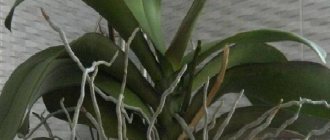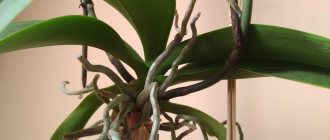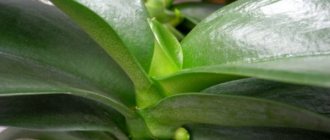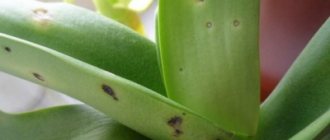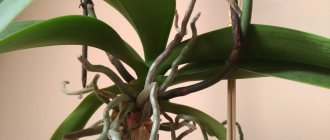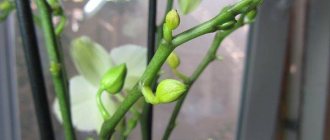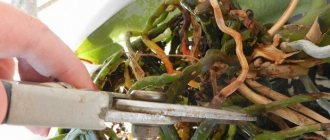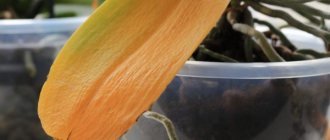Author of the article: Anna Vladimirovna | Updated: 02/23/2022
Waffle iron Kitfort KT-1611, yellow
1790 ₽ More details
Waffle iron Kitfort KT-1611, yellow
1790 ₽ More details
Tabletop stoves Kitfort
The luxuriously beautiful phalaenopsis orchid under natural conditions lives on the surface of other plants and receives nutrients through aerial roots. At home, she is deprived of such freedom in space. Its entire root system is placed in a pot. But it happens that not all roots want to live in any container. They crawl out of the pot and stick out in different directions. So what are these aerial roots of an orchid and why do they behave so strangely, upsetting their admirer? You can find out more about this in this article.
Disease or normal?
When you look at a flower with aerial roots scattered across the surface, you are immediately at a loss as to the reasons for this behavior. After all, after landing, it looked graceful and elegant, but now it looks like a predatory monster with protruding tentacles. Why does this happen in orchids?
There is no need to worry about returning the emerging roots back to the pot, much less cutting them off and letting them dry. For epiphytes, the presence of aerial roots is a natural state. Aerial roots are supporting structures that support the above-ground part of the plant. It is thanks to them that the flower receives a significant amount of moisture from the air and actively participates in the process of photosynthesis. Orchid roots are a good indicator of watering. When there is enough moisture, they have a bright green color; when there is a lack of liquid, they acquire a silver color.
To understand what is happening, it is necessary to understand the structure of the aerial root system. It is represented by elastic flat or cylindrical roots, covered with a dense spongy shell - velamen. Thanks to this coating, the plant’s roots well absorb and accumulate nutrients and moisture from the air. During the dry period, the shell layers (about 15 layers) perform a protective function for the root system, serving as a reservoir for moisture. They have a protective effect in case of mechanical damage.
If there are a significant number of aerial roots (more than three), the watering regime of the phalaenopsis should be monitored. Excessive oversaturation of the substrate with moisture can lead to abundant growth of roots and force them to crawl out, and subsequently contribute to their rotting.
Stimulating flowering
If, after adjusting the care of the orchid, it still does not bloom, the formation of a peduncle can be stimulated using one of several methods.
Dry season simulation
The seasonal cyclicality of tropical rains and drought, characteristic of the natural growing conditions of orchids, can be used to stimulate flowering indoors. To do this, create an artificial dry season:
- the room temperature should not exceed 30℃;
- the interval between waterings is doubled, after which the plant is additionally kept in a warm room without watering for another 4-5 days, in a cool room - up to 7 days;
- the orchid is not sprayed or fed;
- When a flowering arrow appears, plant care is resumed, excluding fertilizing.
If the orchid had excess nitrogen in its diet, a dry season will help get rid of it and stimulate the formation of flower buds.
Warm shower for mild stress
This technique of simulating a tropical rainfall is suitable not only for stimulating growth and flowering, but also for hardening the orchid:
- the plant is watered before showering;
- the soil is covered with polyethylene to prevent water from getting on it;
- the water temperature in the shower should not exceed 35-40℃;
- duration of plant treatment – 10 minutes;
- After the procedure, the orchid is left for 20 minutes. in a closed bath so that the plant cools completely;
- Using a napkin, remove the remaining water from the axils of the leaves;
- In winter, the procedure can be carried out once a month, in summer – once every two weeks.
Important! Stimulation of flowering is carried out against the background of reducing the amount of nitrogen in fertilizing and increasing the content of potassium and phosphorus. To stimulate flowering, the optimal ratio of nitrogen, potassium and phosphorus should be 2:6:6.
Choosing the right filler for planting
The condition of the root system is an indicator of the health of the orchid. The bright green color of the roots indicates the stage of active growth of the plant, the pale green color demonstrates the dilapidation of the velomen. The plant's root system is constantly developing. But the absence of new bright green roots for several months requires paying attention to caring for the orchid.
An improperly prepared substrate for planting an orchid can promote the appearance of aerial roots . Phalaenopsis must be replanted only in special soil for orchids, which includes: the bark of coniferous trees (pine, spruce, larch, pine), sphagnum moss and charcoal in a ratio of 5:2:1, respectively. If the substrate is dense and has poor air exchange, the roots grow upward. Earthen soil is not recommended for planting, as this leads to rotting of the roots. In such cases, it is necessary to provide resuscitation to the plant. It is removed from the pot. Carefully remove from the previous substrate. Then the root system is thoroughly washed and inspected for rotten and dry parts. It is difficult to immediately distinguish living roots from dead ones, but when wet, active roots become green. The dead become black and soft to the touch. Trimming damaged and dried areas is carried out with a disinfected instrument (knife, blade). The cut areas are treated with charcoal powder and left to air dry. The plant is placed in a dry, warm place to dry completely. The rosette of leaves is wiped dry from moisture with a soft cloth to avoid further rotting. After these manipulations, the phalaenopsis is transplanted into a transparent plastic pot with new soil. The plant should not be watered for several days.
Ready-made mixtures for planting can be purchased at specialized garden centers or flower shops. It is recommended to purchase soil from natural ingredients. In addition to the classic composition (coniferous tree bark, moss, activated carbon), to improve the nutritional properties of the substrate, finely chopped fern root, pine cones, coconut fibers or chips, crushed coconut or walnut shells are added.
Reproduction in different ways
Flower propagation can be done in different ways: by aerial roots, bulbs and by dividing the bush. The method of planting by means of aerial roots is considered the simplest and most accessible for every gardener. It is used for mature and well-grown plants. The procedure boils down to dividing the roots. The separated part is then simply planted in the substrate and waits for the plant to grow.
Dividing an orchid bush is a method suitable for sympoidal species, which include cymbidiums, dendrobiums, cattleyas, odontoglossums, oncidiums, miltonias, etc. The reason lies in the fact that these plant varieties have several growing points, so you can easily divide the rhizome into separate parts.
So, first the plant needs to be soaked in warm, settled water for half an hour, and then cleaned of the old soil. Using a disinfected sharp object, you need to divide the rhizome so that at least three pseudobulbs remain in each part. The cut areas need to be processed, the plant dried, and then planted in a prepared container with substrate.
It is rational to plant with bulbs if the orchid is cramped in the pot. The procedure is performed during a planned transplant. The algorithm is as follows:
- Remove the plant from the container in which it is growing.
- Clean the roots from the substrate by soaking.
- Cut the bulbs using a disinfected sharp tool. Only bulbs with roots are suitable.
- Treat the cut areas.
- Plant the plants in containers with soil prepared for them.
It is advisable to plant the bulbs in dry soil and then spray it daily.
Darkening of the roots
The appearance of dark spots on the aerial and ground roots of phalaenopsis may indicate several reasons:
- the presence of a putrefactive process in the root system due to improper watering;
- the appearance of spots as a result of treating the roots with mineral fertilizers, as a result of which salt deposits appear on the roots;
- incorrect concentration of fertilizer dilution, which led to root burns.
Why did the aerial roots of our orchid darken, what should we do to restore and regenerate them?
Treatment
When the roots rot, the plant is removed from the substrate. The root system is treated and cleaned of putrefactive damage. The question often arises: is it possible to cut off almost all the roots due to rotting and save the plants? In cases where the roots have rotted completely and the plant is deprived of root nutrition, resuscitation measures are carried out to provide the flower with moisture and nutrients.
Two methods of arranging orchids are used: above water and in water. When installed above water, the lower part of the plant is immersed in a solution of succinic acid (4 tablets per 1 liter of water) every two days. Can be immersed in a vitamin solution (1 ampoule of vitamins B1, B6, B12 in 1 liter of water). With the water method, the lower part is immersed in water and foliar feeding is systematically carried out. New roots will begin to appear in 2-3 months. Transplantation into the ground is carried out when the roots are at least 5 cm long.
It is also possible for salts to be deposited on the roots when treated with mineral fertilizers. It must be taken into account that the presence of mineral salts is present not only in the fertilizer, but also in tap water. It is recommended to use only filtered soft water.
Burns to the root system when using high concentrations of fertilizers. To avoid such burns, it is advisable to water the plant abundantly 2-3 hours before applying fertilizing.
Unfortunately, root burn when using a high concentration of fertilizer, as well as the deposition of salts from hard water on the roots, cannot be treated.
Plant care
Excessive growth of aerial roots harms the development of the plant. Incorrect care can also add additional hassle. Often the shoots that grow outward begin to rot due to frequent watering or, conversely, dry out due to lack of water and heat and the owner of the plant does not know what to do about it. Option one - you need to get rid of the diseased roots.
You will need scissors, which should be disinfected before cutting. It is not always possible to distinguish healthy roots from diseased ones. Leave the orchid in warm water for an hour. Healthy roots will absorb moisture and turn a soft green color. Now you can safely get rid of diseased and old shoots whose appearance has not changed.
We recommend that you familiarize yourself with complete information about the structure of an orchid. Read about the growing point, pseudobulb, frog, dormant buds and plant children.
The orchid is a capricious plant with an unusual root system. Aerial roots will not become a problem for the growth and development of the plant. With proper care, the orchid will delight its owners with delicate flowers for many years.
